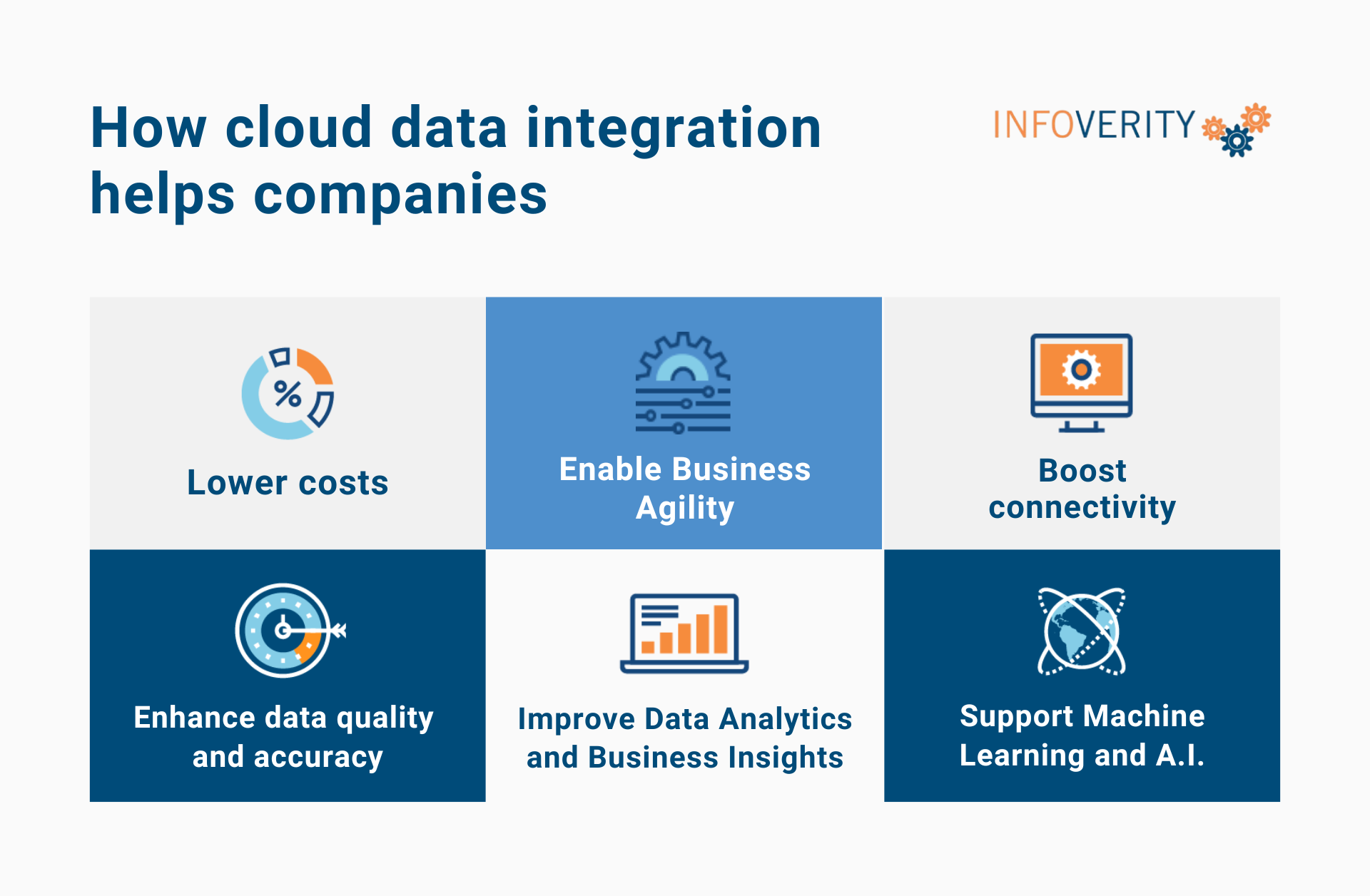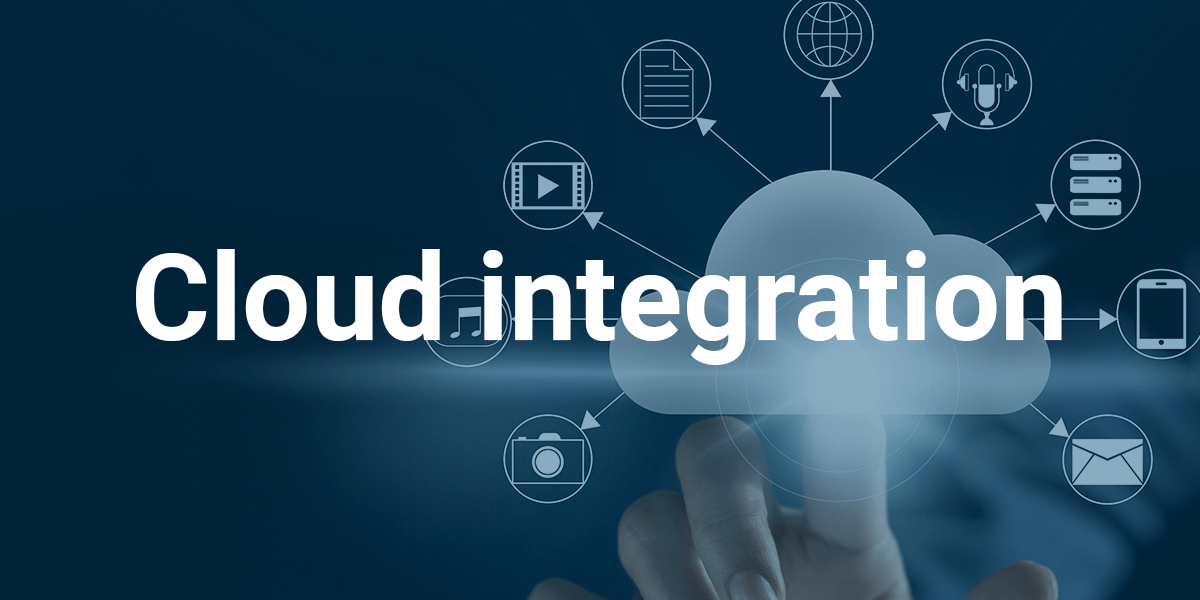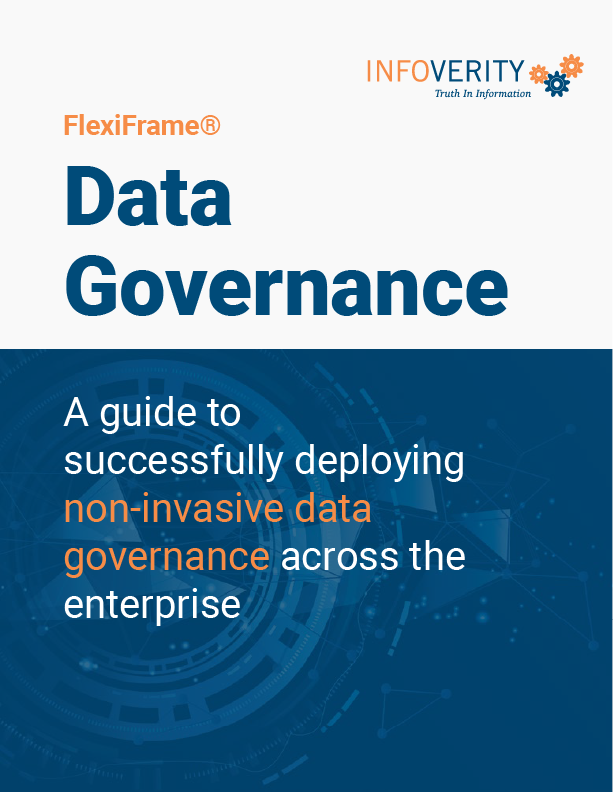Research shows that cloud data integration brings in a 328% average return on investment. Modern organizations are transforming their infrastructure to take advantage of this opportunity.
Cloud data integration brings together a company’s various data sets into a cloud-based repository, such as a data warehouse or a data lake. It solves the tedious and complicated task of finding and retrieving data so that organizations can make informed business decisions faster.
In this article, we’ll discuss what cloud data integration is, its benefits, how it can be implemented, and the tools it requires.
Cloud Data Integration: Table of Contents
How cloud data integration helps companies
- Lower costs. With consolidated and clean data, financial implications of data redundancy will go down. Furthermore, cloud data integration simplifies workflows and eliminates data silos. This allowing businesses to manage any volume of data using ETL engines. To demonstrate this, Forrester reported that 67% of cloud/real-time-data business leaders experienced more effective data management and 59% reduced their organization’s data provisioning expenses.
- Enable Business Agility. Deploying updates and applications faster and reducing access times to datasets can enhance innovative capabilities.
- Boost Connectivity. Cloud integration allows for the use of Application Programming Interface (API) calls to create a steady flow of information between systems. 67% of business leaders also reported that pre-built integrations prevented redundant data flows.
- Enhance Data Quality and Accuracy. When you build data quality into your integration processes, the organization can minimize errors and inconsistencies. For example, data integration is shown to give 70% of IT teams time to focus on strategic endeavors (ex: digital transformation initiatives) rather than routine tasks (ex: system maintenance and updates).
- Improve Data Analytics and Business Insights. 58% of surveyed executives expressed satisfaction with increased data visibility and reporting capabilities across cloud stakeholders. Due to this improvement, and with lower barriers to collaboration, each department can leverage high-value data to drive meaningful business decisions for the whole organization.
- Support Machine Learning and A.I.. AI systems require continuous data integration to remain accurate and responsive. Done right, 59% of surveyed organizations were able to implement generative language models that take data from across cloud applications, while 65% were able to use generative AI for app integration.

Two Types of Cloud Data Integration
There are two types of cloud integration organizations can take advantage of, depending on their needs:
Cloud Hosted Integration
Cloud Hosted Integration involves managing data and applications. Additionally, it leverages cloud-native tools and services to facilitate seamless information flow between multiple applications.
In addition, this approach is scalable, agile, and cost-efficient. It enables companies to adjust resource levels based on demand and remove costs associated with on-premises infrastructure and maintenance.
Hybrid Data Integration
Hybrid Integration combines on-premises systems and cloud-based solutions. As a result, it creates a single infrastructure for apps and data to flow between both environments.
This balanced model is secure, flexible, and handles workloads efficiently. Sensitive data can stay on local data centers, while the cloud infrastructure introduces modernization and innovation to the organization.
It’s ideal for organizations wanting to upgrade their IT infrastructure. All, while keeping existing on-premises investments, have more stringent data security requirements, or are implementing gradual cloud migration.
How Cloud Data Integration Improve Business Processes
Here are two tangible ways it benefits organizations of all sizes.
Build Data Pipelines to Improve Application Integration
Data integration feeds data into a central repository. Consequently, application integration can simply involve pulling data from it and moving it to downstream applications. Cloud integration enhances this by enabling seamless, real-time information flows between systems.
Integrating finance systems with ERP solutions, for instance, ensures timely and accurate sharing of financial data. It reduces errors associated with manual entry and speeds up invoicing cycles. On the other hand, in a mid-sized manufacturing company, the integrated system can generate invoices, updates financial records, and manages accounts receivable in real-time.
In product development, cloud-based data pipelines ensure instant accessibility and compliance updates for the R&D and legal teams. For example, a pharmaceutical company can reduce time-to-market by integrating legal compliance systems with R&D data repositories. Therefore, ensuring new products meet regulatory standards.
Build Robust Systems with Reduced Downtime by Decoupling Systems
Decoupling involves designing software architectures where components operate and communicate independently. Cloud computing demonstrates a decoupled architecture, since providers only handle the physical infrastructure, not applications or data. Because of this, a failure in one system won’t directly interfere with others.
For example, an analytics platform collects data from multiple operational databases on a regular basis, processes it, and generates reports without impacting sales and inventory systems.
For this reason, data integration also helps optimize workflows and ensures continuous system availability that can positively impact customer’s journey. E-commerce platforms can decouple order management from customer service systems. Even if the ordering system fails, customer service can access order histories.
Looking for cloud integration or modernization guidance?
Infoverity can help your business with the entire cloud modernization and integration process. Auditing your current systems and providing informed advice on the best cloud tools for your business 
Three Types of Cloud Integration Tools
Cloud Service Provider-Based Tools
Major providers offer data integration tools that enable seamless integration between diverse applications.
- Azure. Microsoft Azure provides tools like Azure Data Factory. Specifically, this service offers a managed solution for ETL (Extract, Transform, Load) processes and orchestrating data workflows. It integrates with numerous data sources, both on-premises and in the cloud.
- Amazon Web Services. AWS offers AWS Glue, identifies data across AWS, on-premises, and other clouds, and enables instant querying and transformation.
- Google Cloud. Google Cloud has a suite of tools, this includes Cloud Data Fusion. The last is a fully managed, cloud-native data integration service that allows users to build, manage and analyze their ETL/ELT pipelines with ease.
Data Management Platform Vendors
Informatica Cloud Data Integration & Cloud Application Integration. Informatica offers advanced and complex integrations for organizations and can be run at scale using serverless environments or Spark. Also, it has Cloud Data Quality (CDQ) to resolve data quality issues immediately. Also, it has Cloud Data Quality and Governance Catalog (CDGC) to assist with objectives like tracking application lineage.
Dedicated Integration Tools
Beyond cloud service providers, dedicated tools provide specialized capabilities:
- MuleSoft. MuleSoft’s Anypoint Platform helps companies achieve better ETL/ELT data integration. Also, company developed DataWeave data language, designed for real-time and batch data integration at scale.
- Dell Boomi. Boomi’s cloud-native integration platform has pre-built application connectors and integration recipes.
The Cloud and Digital Transformation
Integrating cloud data improves data accuracy and access, reduces costs through automation and consolidation, and fosters innovation. That is why, companies need to get on board to reap the benefits of cloud integration and transform themselves into a insights-driven organization.
At Infoverity, we specialize in guiding companies through this transformative journey, ensuring seamless data integration and maximizing the value of their data assets. Therefore, contact our experts today to explore how we can assist you in harnessing the full potential of your business.
FAQ – Cloud Integration
What is cloud integration?
Cloud Data Integration brings together a company’s various data sets into a cloud-based repository, such as a data warehouse or a data lake. It solves the tedious and complicated task of finding and retrieving data so that organizations can make informed business decisions faster.
What are the types of cloud data integration?
There are two types of cloud data integration organizations can take advantage of, depending on their needs: Cloud Hosted Integration and Hybrid Data Integration. Choosing the right approach depends on your organization’s needs, security policies, and digital transformation goals.
What is the best cloud integration platform?
The best data integration platform depends on your organization's specific needs, infrastructure, and scalability requirements. There are several powerful options available, categorized into three main types: Cloud Service Provider-Based Tools, Data Management Platform Vendors and Dedicated Integration Tools.
How cloud data integration can help companies?
Cloud data integration streamlines business processes by enhancing application integration and reducing downtime and improving reliability. By enabling seamless data flow, cloud integration helps businesses optimize workflows, improve decision-making, and enhance the customer experience.
Download The Guide
Looking for a guide to deploy non-invasive data governance across your organization?
Download our free white paper and discover how to implement data governance seamlessly at your company.



